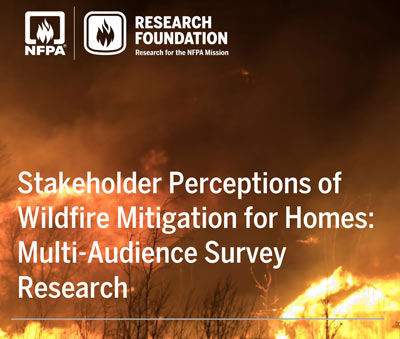July 2, 2024 - In an effort to help wildland urban interface (WUI) communities better protect their homes against wildfire, 
According to the report, only half of the residents surveyed knew what specific actions they can take to reduce their homes’ risk to wildfire. Less than half (43 percent) knew where to find resources to help complete them. Only three percent of residents are aware of government grants, insurance discounts, and other incentives to participate in residential wildfire risk reduction. However, those who have taken advantage of such incentives are much more likely to implement a broad range of safety efforts.
“While the survey shows that residents overwhelmingly understand their wildfire risks, few people are conducting all the measures needed to mitigate them, and most aren’t doing the work as often as they should,” said Michele Steinberg, director of the Wildfire Division at NFPA. “We need to pull all available levers to help motivate residents to action. In spite of all the funding and support available from government and private organizations, most residents aren’t getting the message about these important resources.”
Key findings from the survey include the following:
- Seventy-nine percent of residents surveyed were at least somewhat motivated to learn more about wildfire mitigation measures for their property, including a quarter (25 percent) who were very motivated.
- Most residents have performed some form of vegetation maintenance mitigation measure at any point in time (79 to 91 percent) or at least once a year (63 to 79 percent).
- Seventy-six percent of surveyed jurisdictions said there were “not enough resources and/or funding to help property owners”; 83 percent of jurisdictions reported a “lack of funding and resources” to be a major obstacle.
- More fire departments have programs to assist residents in implementing vegetation management (52 percent) than home hardening/structure modification (35 percent).
Among the more promising survey results, residents who place a high value on the privacy and natural setting that the wildland urban interface (WUI) offers do not perceive mitigation efforts as problematic. On the contrary, these residents are highly engaged in wildfire risk reduction efforts. And those who are educated on wildfire risk and mitigation are not only motivated to learn more but also are more likely to take on risk reduction projects.
“Overall, the survey findings offer a mix of encouraging information about what motivates residents to mitigate wildfire risks on and around their homes, along with persistent obstacles that tend to hold them back,” said Steinberg. “These results help identify ways to increase participation in wildfire risk reduction and where we need to break through barriers, with the ultimate goal of empowering residents to become more proactively engaged in wildfire mitigation.”
Conducted by EurekaFacts, LLC, the wildfire survey targeted government officials, local fire departments, and residents in California and Oregon, states that both face elevated wildfire risks. NFPA will use the survey findings to develop information and messaging to better motivate residential wildfire risk reduction efforts.
Download the full “Stakeholder Perceptions of Wildfire Mitigation for Homes: Multi-Audience Survey Research” report.
NFPA Wildfire Information & Resources
- The NFPA Wildfire Division provides resources to residents and safety professionals to help ensure everyone living in communities at risk has the information and tools to prepare and protect their homes from wildfire. Visit nfpa.org/wildfire to learn more.
For this release and other announcements about NFPA initiatives, research, and resources, please visit the NFPA press room.
About the National Fire Protection Association (NFPA)
Founded in 1896, NFPA is a global self-funded nonprofit organization devoted to eliminating death, injury, property and economic loss due to fire, electrical and related hazards. The association delivers information and knowledge through more than 300 consensus codes and standards, research, training, education, outreach and advocacy; and by partnering with others who share an interest in furthering the NFPA mission. For more information, visit www.nfpa.org. All NFPA codes and standards can be viewed online for free at www.nfpa.org/freeaccess.
Source: NFPA








